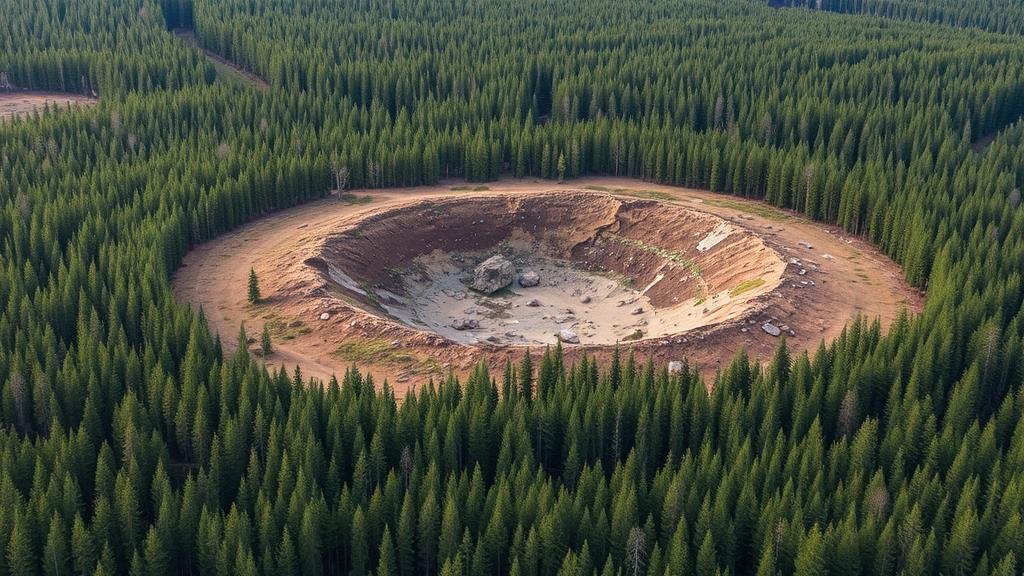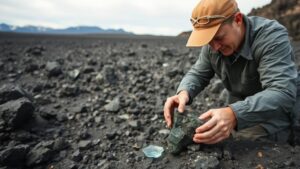Searching for ancient meteorite craters in Canada’s Shield, hidden beneath dense forest canopies.
Searching for Ancient Meteorite Craters in Canada’s Shield
Canada’s Shield, a region renowned for its ancient geological history, is a treasure trove for rockhounds and mineral collectors, particularly those interested in the fascinating world of meteorite craters. These craters, remnants of cosmic collisions, offer insights into both planetary science and Earths geological past. But, the dense forest canopies of the Shield can make uncovering these ancient impacts a challenging but rewarding endeavor.
The Geological Background of the Canadian Shield
The Canadian Shield, one of the worlds largest geological continental shields, is primarily composed of Precambrian crystalline rocks. This region spans over 8 million square kilometers and covers parts of eight provinces and territories. The shield has been subjected to billions of years of geological activity, including plate tectonics, glaciation, and, notably, meteorite impacts. Its estimated that around 250 impact craters can be found across Canada, but many remain hidden beneath forest cover.
- Age and Composition: The rocks of the Shield date back as far as 4 billion years and consist mainly of granite and gneiss.
- Impact Events: The most recognized impacts include the Sudbury Basin and the Manicouagan crater, amongst others.
Finding Meteorite Craters
Locating meteorite craters in the Canadian Shield requires a blend of scientific method, technological tools, and old-fashioned exploration. Here are some key strategies for aspiring collectors:
- Utilizing Geological Maps: Start with geological maps that highlight known impact sites and geological formations. The Geological Survey of Canada produces detailed maps that can aid in initial planning.
- Satellite Imagery: Modern technology provides access to detailed satellite images. Tools like Google Earth can help you identify anomalies in the forest canopy that may indicate underlying craters.
- Consulting Local Experts: Engaging with local universities or geological societies can provide invaluable insights and data on recent discoveries in the region.
Understanding the Ecological Challenges
The dense forests of the Canadian Shield pose significant obstacles when conducting exploratory searches for meteorite craters:
- Accessibility: Many areas are remote, requiring hiking, off-road vehicles, or even boating to reach potential sites. Plan your trips according to the season to avoid the heavy foliage of summer and the harsh winters.
- Environmental Considerations: As a collector, its essential to respect the natural environment. Follow the Leave No Trace principles to minimize your impact on these delicate ecosystems.
Indicators of Meteorite Presence
Rockhounds often look for specific indicators that can signal the presence of meteorites associated with craters:
- Unusual Rock Types: Look for shocked quartz or glassy materials that might indicate an impact event.
- Magnetic Anomalies: Many meteorites are rich in iron and can create unique magnetic signatures that can be detected with a magnetometer.
The Benefits of Meteorite Hunting
Engaging in the hunt for meteorite craters offers both educational and practical benefits:
- Scientific Knowledge: Collectors gain firsthand experience with geological formations and impact theories while contributing to scientific understanding.
- Collector Value: Meteorites can hold significant monetary value and be highly sought after for personal collections or educational displays.
Real-World Applications and Community Resources
Many organizations and communities are dedicated to educating and assisting rockhounds in their endeavors:
- Local Rockhounding Clubs: Join clubs such as the Ottawa Valley Rock and Mineral Club to connect with like-minded enthusiasts.
- Field Guides and Resource Books: Use publications that specialize in meteorites and Canadian geology for reference during your expeditions.
Conclusion: Embrace the Adventure
Searching for ancient meteorite craters in Canada’s Shield offers a unique blend of adventure, scientific discovery, and personal fulfillment. By leveraging technological tools, engaging with community resources, and adhering to ethical practices, rockhounds can uncover the hidden treasures beneath the forest canopies. As you embark on this journey, remember that it’s not just about uncovering meteorites, but the joy of exploration and the wealth of knowledge gained along the way.



